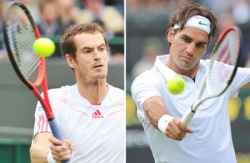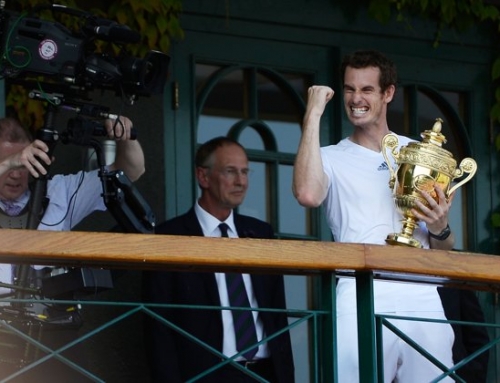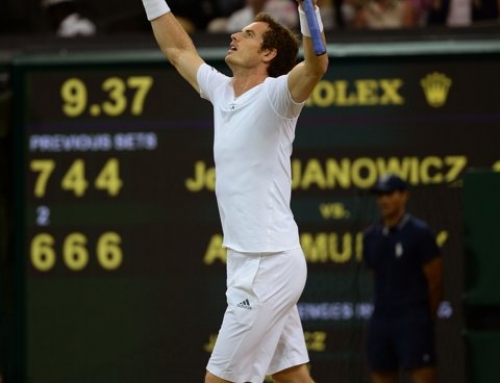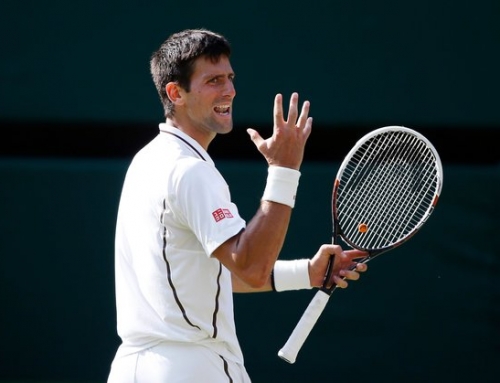 Heading into the finals, there are a bunch of stories that one can focus on. It’s the first Slam in a while where neither Rafael Nadal nor Novak Djokovic are playing. The last time this happened was only a year ago, at the French Open, when Federer beat Novak Djokovic, to reach the finals and, once again, lost to Rafael Nadal. Other than that, Roger is heading into his 8th Wimbledon final trying to win his 7th title. He must have felt missed opportunities the last two years, though he can always say “I have 6 Wimbledons”, so it’s amazing how Roger can put away losses and not worry about it even if means he may never reach 20 Slam titles.
Heading into the finals, there are a bunch of stories that one can focus on. It’s the first Slam in a while where neither Rafael Nadal nor Novak Djokovic are playing. The last time this happened was only a year ago, at the French Open, when Federer beat Novak Djokovic, to reach the finals and, once again, lost to Rafael Nadal. Other than that, Roger is heading into his 8th Wimbledon final trying to win his 7th title. He must have felt missed opportunities the last two years, though he can always say “I have 6 Wimbledons”, so it’s amazing how Roger can put away losses and not worry about it even if means he may never reach 20 Slam titles.
Let’s look at it from Roger’s perspective. Roger hasn’t been the dominant player he was between 2005-2007. 2008 was the big turning point when Rafa finally beat Roger Federer in the finals of Wimbledon. Rafa had already been in the finals twice before and shown that his clay-only game was a myth. Rafa’s ability to hit tennis balls at his ankles and above his shoulders have given him the skills needed to play on the low bouncing grass. Roger’s problems have lately been reaching the finals. He’s struggled to play big servers with big forehands in Berdych and Tsonga. He got away with it in 2009 in the finals where he won two tiebreaks and broke once in the fifth set.
Should Roger win the finals, and he’s favored, both because he’s higher ranked, and because he’s played in so many Slam finals and won so many of them, he’ll tie Sampras’s record 7 Wimbledon titles. He’ll also enter the ranks at number 1 on Monday, and with the top players not playing for a month, he’ll stay at number 1 for about a month, thus surpassing Sampras’s record of 286 weeks (Roger is at 285) at number 1. Roger must have known this might be possible and decided to play Rotterdam, a tournament he’s rarely played. Roger pushed very hard to do well after the US Open up through Indian Wells so he could keep his rank high enough that if he did well in the Slams, he could theoretically reach number 1.
Roger goes into the finals confident. He doesn’t have to play Rafa. Although he’d be reasonably confident to play Rafa on grass, it certainly doesn’t hurt not to play a guy he’s had a losing record to. The last time he played Murray, in the finals of Dubai, he won 75 64. Roger would go on to win Indian Wells as well.
Historically, Murray has played Federer by being patient. He’s wanted to take advantage of Federer’s erratic play. Alas, Roger plays Slams differently than normal tournaments. At times, Roger will play very quick, try to win in 5-6 shots, even if this means making errors, just so he doesn’t tax his body. If he loses, he loses, but he’s not worried about it. In Slams, he’ll start to play the 20 shot rallies. It’s not that he wants to do that–a short rally will be fine, but it’s worth more to him, and so he’s willing to take more physical abuse just to win. Murray’s assumed Federer would just play poorly and being steady would be enough. Twice, Murray has tried to be more aggressive, only to find he’s run out of time.
For Murray, making the Wimbledon final has been a huge hurdle. 2009 was his best opportunity when Nadal was not playing and he was taking on Andy Roddick, a player he normally does well against. However, Roddick was playing pretty well that year and taking two tiebreaks gave him a big edge over Murray. But other than that, Rafa has been his main rival. Rafa beat him in the quarterfinals in 2008, and the semis in 2010 and 2011. By contrast, Murray had beaten Tsonga every time they’ve met except the first time back in the 2008 Australian Open. He was pushed to four sets, but managed to break when he had to break.
Murray’s tough road may have given him an additional edge. He’s had points where he just had to break or be in big trouble. This was nowhere more evident than in the second set in the quarterfinal match against David Ferrer when Murray was down a break, 5-4, and had to break to avoid going down two sets to love. Even in the tiebreak, he was down initially. He even had to deal with having break points to serve out the fourth set, but saw Ferrer hold, and push the match into a tiebreak.
Murray’s appearance in the final is historic. No British male player has reached the Wimbledon singles finals since 1938 when Bunny Austin reached the finals and no one has won in since 1936 when Fred Perry last won the title.
Murray has had to deal with the pressure of succeeding at Wimbledon for years. Back in 2008, British announcers were saying he had to reach the semifinals. At that time, Rafa Nadal was the roadblock, and no, he didn’t beat Rafa in the quarterfinals. The last hope for British success at Wimbledon was Tim Henman. Henman played in this transitionary era of the 1990s. When Agassi was big, that is, in the late 1980s, he was bringing a style that would soon be emulated, but it would take about a decade for players to transition to that style of play. Some were already doing it because of players like Lendl who played power tennis in the early 1980s. Back in the 1970s, you were generally a baseliner or a serve and volleyer. Serve and volleyers often ignored their baseline game, so they would lose to any decent baseliner.
By the 1990s, with topspin as the weapon of choice in passing shots, serve and volleyers had to spend time improving their ground game. Henman was one of those players. Sure his groundstrokes weren’t world beating–he was a serve and volleyer, after all–but they were decent enough to keep him in matches. And the fact is, Henman was not a top 5 player. He overachieved on the grass, getting his game so he could maximize it on grass. Henman won only 11 titles in his career. Murray has already won twice that many titles. By every measure, Andy Murray is the better player. Henman just couldn’t get over the hump of players like Pete Sampras, but Murray might be able to get over the hump of Roger Federer.
Much has been made of Ivan Lendl joining the Andy Murray camp. Murray had, famously, worked with Brad Gilbert, but everyone who has worked with Gilbert since Andre Agassi has dumped him. Only Agassi, it seems, had the patience to deal with the non-stop gabfest that is Brad Gilbert. His presence suffocated two Andy’s, Andy Roddick and Andy Murray. Even though Roddick won his only Slam under Gilbert, he seems pretty content never to win another if it means he doesn’t have to be coached by Gilbert.
Lendl and Murray have somewhat similar background. Lendl was a very analytical person, and tried to leave no stone unturned when it came to his own success. He had a house near the US Open where he would get the same people that paved the tennis courts at Flushing Meadows to do the same for his own personal courts. He was the first to work on his diet, on his strength, doing training away from the court. Martina Navratilova did the same for the women’s game. Lendl would change his racquets during every ball change so he would get a fresh set of strings. He had a personal stringer that also made sure his racquets were as identical as possible. In the days of wooden racquets, quality control was not good enough to prevent minute variations in racquets, but by the time Lendl played, they could start to compensate for the differences.
Lendl famously trained with up-and-coming juniors, although that may have hurt him when it came to Pete Sampras who famously beat him in 1990 because he wasn’t scared of the Czech superstar.
And, yes, like Andy Murray, Lendl failed to win his first few Slams. However, everyone felt that his time would come sooner or later. At the time, he was considered the hardest hitter on tour. It would be a little like maybe Juan Martin del Potro making it to the finals of Slams on a regular basis and losing rather than Murray.
When it came to Wimbledon, Lendl was happy to skip the event in the early days claiming an allergy and saying grass is for cows. However, he later grew obsessed with winning Wimbledon, even sacrificing potential chances to win the French to focus on Wimbledon. Lendl learned to play the serve and volley style. He became reasonably good, though never quite natural at it. Even so, what player would ever do something like that? In fact, no good baseliner of Lendl’s day learned to play serve and volley just to win Wimbledon. Wilander was OK at the serve and volley, but it wasn’t his go-to strategy on grass. The closest modern player to attempt this? Andy Murray’s last opponent, Jo-Wilfried Tsonga.
By contrast, Andy Murray is not the hardest hitter on tour. Arguably, the hardest hitters never got to the very top. Fernando Gonzalez, Fernando Verdasco, Juan Martin del Potro all have formidable forehands. You might add Federer and Nadal to that mix. But Murray? His forehand has become more powerful as the years have gone by. His backhand is similarly powerful. But it’s hard for him to reliably hit hard, and in this year’s Wimbledon, he’s decided to go back to the style that made Murray the player everyone thought he was.
Contrast how Murray played on clay where he primarily hit topspin on his backhand, Murray has been throwing in slices, drop shots, short crosscourt approach shots. He’s opening up his playbook. But all of this is anchored by his serve. At his best, which was the first two sets of the Tsonga match, Murray’s serve is flowing so easily that he resembles Federer more than anyone else. Federer’s success has hinged on winning his own serve easily, and Murray is trying to emulate that.
What are the keys to Murray’s success? First, he needs to win free points off that first serve. His serve went awry at the start of the third set against Tsonga, and he’ll want to avoid that. Historically, Federer has had issues returning serve at Wimbledon. Indeed, it’s knocked him out the last few years. Even the year he won it (2009), he could hardly break serve. So it’s critical that Murray get good first serves.
Second, he’ll need to save break points. Murray has been doing a better job of avoiding the break. As he’s gotten break points down, he’s relied on serves and his ground game to bail him out.
Third, he needs to get into Roger’s service games and start to play lengthier points, and he’ll want to do this using his backhand. Roger is a bit vulnerable to lefties, and so Murray can emulate this by using his crosscourt backhands to open up the down the line backhand.
Roger’s main strategy, in some ways, is a bit simpler. Hold serve. Roger is really good at holding serve, and the more he does this, the more pressure he applies on the return game. Roger has taken a contrarian attitude to improving his game. He’s generally worked on his strengths (his serve, primarily), but he’s worked hard lately at building up his backhand. It was his improved backhand that allowed him to stay in rallies with Djokovic. Arguably, Djokovic was really concerned with the footing, and wasn’t able to move nearly as confidently as he is used to, but Djokovic found himself defending a lot more than he has in the past against Federer, and so that unnerved him. It probably didn’t hurt that lower balls–the kinds you find on Wimbledon grass–fall more in Fed’s strike zone.
Roger will also feel confident playing Murray knowing he can beat him. I think he feels the same about Djokovic, to be honest, and the only guy he doesn’t feel that confidence against is Nadal.
OK, so who do I think is going to win. If it came down to experience, clearly Federer would win, but Murray has also gained a bit of experience. Murray will have to play really well, but I think the experience of playing Fed in so many finals, and with Lendl at his side, may give him that last needed push to win. However, I can see it being close. Murray’s first job is merely to win that first set since he’s not even won a set in a Slam. He was close in 2010, but couldn’t quite win that third set tiebreak in Melbourne. It would help Murray’s cause if he gets out to a quick start since Fed is such a great front runner.
I’ll be curious to see if there are any weird twists to this match, though I think Murray’s generally revealed the style of play he wants to use.







![[Wimbledon, QF] Murray scraps out 5-set win over Verdasco to reach semifinals](https://www.essentialtennis.com/wp-content/uploads/2013/07/20130703murray-500x383.jpg)